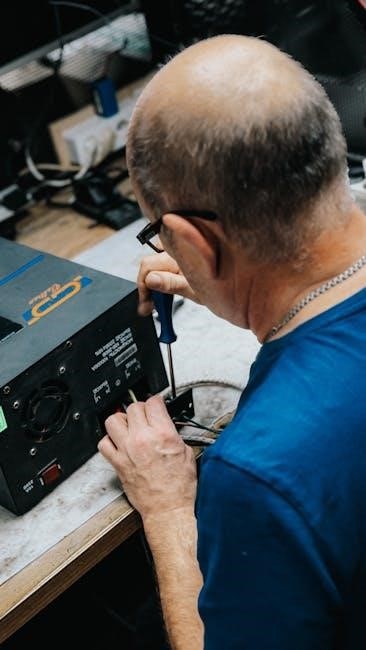Basic Electronics is the foundational study of electrical components, circuits, and systems. It covers essential concepts like voltage, current, resistance, Ohm’s Law, and electronic components, providing a core understanding of modern technology.
1.1 What is Basic Electronics?
Basic Electronics involves the study of electrical components, circuits, and systems. It focuses on understanding fundamental concepts like voltage, current, resistance, and Ohm’s Law. This field introduces essential components such as resistors, capacitors, and inductors, and explores their roles in electronic circuits. It also covers basic circuit analysis, including series and parallel configurations. Basic Electronics serves as the foundation for more advanced topics in electronics and is crucial for designing and troubleshooting simple electronic systems. It is a vital starting point for anyone interested in electronics engineering.
1.2 Importance of Basic Electronics in Modern Technology
Basic Electronics is fundamental to modern technology, enabling the development of communication devices, computers, and smart systems. It underpins advancements in fields like robotics, medical devices, and renewable energy. Understanding basic principles ensures efficient design and troubleshooting of electronic systems. From consumer electronics to industrial automation, basic electronics provides the core knowledge needed to innovate and maintain modern technological infrastructure, making it indispensable in today’s digital world.
Fundamental Concepts in Electronics
Electronics revolves around understanding voltage, current, and resistance, forming the basis of circuit analysis. These principles guide the design and functionality of modern electronic systems and devices.
2.1 Voltage, Current, and Resistance
Voltage is the potential difference driving electric current, measured in volts (V). Current is the flow rate of electrons, measured in amperes (A). Resistance opposes current flow, measured in ohms (Ω). These fundamental concepts are interconnected through Ohm’s Law, V=I×R, which is crucial for understanding and analyzing electronic circuits. Grasping these basics is essential for designing and troubleshooting circuits in various applications, making them a cornerstone of electronics education and practice.
2.2 Ohm’s Law and Its Applications
Ohm’s Law states that voltage (V) equals current (I) multiplied by resistance (R), expressed as V=I×R. This fundamental principle helps analyze and design electronic circuits, enabling calculations of unknown values when two are known. It is widely used in power calculations, circuit troubleshooting, and component selection. Understanding Ohm’s Law is essential for both theoretical and practical applications in electronics, providing a foundation for more complex circuit analysis and design.
2.3 Power, Energy, and Efficiency in Electronic Circuits
Power in electronics is the rate of energy transfer, calculated as P=V×I (voltage multiplied by current). Energy represents the total work done over time, measured in joules. Efficiency is the ratio of output power to input power, indicating how effectively a circuit operates. Understanding these concepts is crucial for designing circuits, minimizing energy loss, and optimizing performance. High efficiency reduces heat generation and prolongs battery life, making it vital for modern electronic systems and sustainable technologies.

Essential Electronic Components
Resistors, capacitors, and inductors are fundamental components in electronic circuits. They regulate voltage, store energy, and manage magnetic fields. Other key components include transistors and diodes, which control and direct current flow efficiently.
3.1 Resistors: Types and Functions
Resistors are essential components that oppose the flow of electric current. They are available in fixed and variable types, with fixed resistors having set values and variable resistors adjustable. Resistors are used to limit current, divide voltage, and protect circuits from overcurrent. Common types include carbon film, metal film, and wirewound resistors. Their values are measured in ohms, and they play a critical role in ensuring proper circuit operation by controlling electrical energy flow efficiently.
3.2 Capacitors: Properties and Applications
Capacitors store electrical energy in an electric field. They consist of two conductive plates separated by a dielectric material. Capacitance is measured in farads, indicating energy storage capacity. Types include fixed and variable capacitors, with materials like ceramic, electrolytic, and film. Capacitors are used for filtering, coupling, and energy storage in circuits. They play a crucial role in modern electronics, from power supplies to audio equipment, by stabilizing voltage and reducing ripple in power lines, ensuring efficient energy flow and signal integrity.
3.3 Inductors: Role in Electronic Circuits

Inductors are passive components that store energy in a magnetic field when current flows through them. Their key property is inductance, measured in henrys (H). Inductors oppose changes in current, making them essential for filtering, tuning, and voltage regulation. Common types include air-core, iron-core, and ferrite-core inductors. They are widely used in power supplies, radio circuits, and audio systems to smooth voltage fluctuations and ensure stable signal transmission, playing a vital role in modern electronic systems by managing energy flow and reducing interference.

Series and Parallel Circuits
Series circuits connect components end-to-end, sharing a single current path, while parallel circuits connect components across the same voltage source, allowing multiple paths for current flow.
4.1 Understanding Series Circuits
In a series circuit, components are connected end-to-end, creating a single path for current flow. The current remains the same throughout the circuit, while voltage drops add up across components. This configuration is essential for understanding basic circuit behavior, as it simplifies the analysis of power distribution and resistance. Series circuits are fundamental in electronic design, offering a straightforward approach to connecting devices like LEDs and resistors in various applications.
4.2 Understanding Parallel Circuits
In a parallel circuit, components are connected across the same two points, allowing multiple paths for current flow. Each component receives the same voltage, but current divides among branches. This configuration is ideal for maintaining consistent voltage across devices, such as in household wiring and battery connections. Parallel circuits are crucial for understanding how to design efficient and safe electronic systems, ensuring components operate within their voltage ratings while allowing flexibility in circuit design.
4.3 Comparing Series and Parallel Configurations
Series circuits have components in a single path, sharing the same current, while parallel circuits provide multiple paths, allowing independent current flow. In series, voltage drops add up, but in parallel, voltage remains consistent across all branches. Parallel circuits are more flexible, as components can be added or removed without affecting others, making them ideal for applications like household wiring. Series circuits, however, are simpler and often used in LED lighting or battery configurations, where consistent current flow is essential for operation. Understanding both configurations is crucial for designing efficient electronic systems.
Circuit Analysis and Design

Circuit analysis involves studying nodes, loops, and branches to understand voltage, current, and power flow. Design focuses on creating functional circuits, like simple LED configurations, using theoretical principles.
5.1 Nodes, Loops, and Branches in Circuit Analysis
In circuit analysis, nodes represent connection points of components, while loops are closed paths where currents flow. Branches are segments between nodes carrying specific currents. These concepts are fundamental for applying Kirchhoff’s Laws, enabling the analysis of voltage and current distributions in complex circuits. Understanding nodes, loops, and branches is essential for circuit theory and practical applications, such as simplifying circuit behavior and simulating electronic systems.
5.2 Time Domain Analysis of Electronic Circuits
Time domain analysis examines how voltage and current in a circuit change over time. It is crucial for understanding transient behavior, such as voltage spikes or signal fluctuations. This method helps identify circuit stability and predict performance under varying conditions. By plotting electrical variables against time, engineers can troubleshoot issues and ensure reliable circuit operation. Time domain analysis is essential for designing and analyzing dynamic electronic systems, ensuring they function as intended in real-world applications.
5.3 Designing Simple LED Circuits
Designing simple LED circuits is a fundamental project in basic electronics. It involves connecting an LED, a resistor, and a power source, such as a 9V battery. The resistor ensures the LED operates within safe voltage limits, preventing damage. This project teaches circuit design basics, component selection, and practical soldering skills. It serves as an excellent introduction to electronics, helping beginners understand how circuits function and how to apply theoretical knowledge to real-world applications.
Safety Precautions in Electronics
Safety is crucial in electronics to prevent accidents. Always use protective gear, ensure proper tool handling, and avoid live circuits. Supervision is essential when working with mains power.
6.1 General Industrial Safety Guidelines

Safety in electronics involves wearing protective gear like gloves and goggles. Avoid loose jewelry that may conduct electricity. Ensure proper ventilation to prevent fume inhalation from soldering. Keep work areas clean and well-lit. Use tools correctly and avoid overloading circuits. Regularly inspect equipment for damage. Never work on live circuits without proper precautions. Stay alert and follow established protocols to minimize risks. Supervision is essential, especially for beginners. Neglecting safety can lead to injuries or equipment damage.
6.2 Safe Handling of Electronic Components
Safely handling electronic components is crucial to prevent damage and ensure reliability. Always handle components by the edges to avoid static discharge. Use anti-static wrist straps or mats when working with sensitive parts. Avoid touching pins or leads, as oils from skin can cause corrosion. Store components in protective packaging or labeled containers. Handle sharp components like capacitors with care to prevent injury. Proper handling extends component lifespan and maintains circuit performance. Regularly inspect components for damage before use.
6.3 Working with Mains-Powered Circuits
Working with mains-powered circuits requires extreme caution due to the risk of electric shock. Always disconnect the power supply before starting work. Use a multimeter to verify zero voltage at all points. Avoid working alone and ensure proper insulation of tools and gloves. Never touch live wires or components with bare hands. Follow local safety regulations and ensure all circuits are de-energized before handling. Proper precautions protect both personnel and equipment from potential hazards.

Tools and Instruments for Electronics
Essential tools include multimeters for measuring voltage, current, and resistance, soldering irons for component assembly, and breadboards for prototyping circuits. These instruments are vital for electronics work.
7.1 Multimeters: Functions and Usage
A multimeter is a versatile tool for measuring voltage, current, resistance, and continuity in electronic circuits. It combines multiple measurement functions in one device, making it indispensable for troubleshooting and diagnostics. Digital multimeters offer high precision, while analog models provide a visual representation of changing values. Proper usage involves selecting the correct range and connecting leads safely. Understanding multimeter functions is essential for diagnosing faults and ensuring circuit safety. Regular calibration ensures accurate readings, making it a cornerstone of electronics work.
7.2 Soldering Irons and Soldering Techniques
Soldering irons are essential tools for connecting electronic components. They use heat to melt solder, creating secure electrical bonds. Temperature-controlled irons are ideal for precision work, while pencil-type irons are common for basic tasks. Proper soldering techniques involve cleaning the iron tip, applying flux, and heating both the component and pad evenly. Desoldering requires care to avoid damaging components. Safety precautions, such as using a heat-resistant surface and insulated handle, are crucial. Practice and patience are key to mastering soldering skills for reliable electronic connections.
7.3 Breadboards and Prototyping Tools
Breadboards are essential for prototyping electronic circuits, allowing temporary connections without soldering. They consist of rows and columns of sockets connected by internal wires, enabling easy component placement and testing. Power rails simplify voltage distribution, while jumper wires connect components. Additional tools like IC sockets and breakout boards enhance versatility. Breadboards are reusable, making them ideal for experimentation and education. Proper organization and planning are crucial to avoid short circuits and ensure reliable connections during the prototyping process.
Operational Amplifiers (Op-Amps) are versatile integrated circuits used to amplify weak signals and perform mathematical operations. They are fundamental in analog electronics, enabling applications like voltage adders, subtractors, integrators, and differentiators.
8.1 Basic Applications of Operational Amplifiers

Operational Amplifiers (Op-Amps) are fundamental components in electronic circuits, offering high versatility. Their basic applications include signal amplification, voltage regulation, and mathematical operations like addition and subtraction. Op-Amps are crucial in filters, integrators, and differentiators, enabling precise signal processing. They are widely used in audio equipment, medical devices, and industrial control systems, making them indispensable in modern electronics for achieving accurate and reliable circuit performance.
8.2 Voltage Adders, Subtractors, Integrators, and Differentiators
Op-Amps can be configured as voltage adders or subtractors by adding resistors to their inputs, enabling precise signal combination or subtraction. Integrators use capacitors in the feedback loop to process signals over time, while differentiators perform the opposite function, responding to signal changes. These configurations are essential in signal processing, filtering, and waveform generation, making them versatile tools in electronic circuit design for achieving complex functionalities with simplicity and accuracy.

Digital Electronics Basics
Digital Electronics Basics introduces logic gates, binary systems, and circuit design. It explores the fundamentals of digital signals, truth tables, and practical applications in modern computing systems.
Logic gates are fundamental components in digital electronics, representing the building blocks of digital circuits. They process binary inputs (0 or 1) to produce specific outputs based on logical operations. Common types include AND, OR, NOT, NAND, NOR, XOR, and XNOR gates. These gates form the basis of digital systems, enabling tasks like arithmetic operations and data manipulation. Understanding logic gates is crucial for designing and analyzing digital circuits, making them essential in computing and modern electronic systems.
9.2 Design and Analysis of Digital Circuits
Digital circuit design involves creating systems that process binary data using logic gates and integrated circuits. Analysis ensures these circuits function as intended, using tools like truth tables and Karnaugh maps. Simulation software aids in testing and refining designs. Understanding timing diagrams and signal propagation is crucial for optimizing performance. This process is fundamental for developing modern electronic systems, from simple controllers to complex processors, ensuring reliability and efficiency in digital operations.

Troubleshooting Electronic Circuits
Troubleshooting is a critical skill in electronics, involving identifying and repairing faults in circuits. Common issues include open circuits, short circuits, and component failures. Using tools like multimeters and oscilloscopes, technicians diagnose problems systematically. Practical exercises and debugging techniques enhance proficiency in restoring circuit functionality efficiently.
10.1 Common Faults in Electronic Circuits
Common faults in electronic circuits include open circuits, short circuits, and component failures. Open circuits occur when a break in the wire or component disrupts the flow of current. Short circuits happen when two or more wires mistakenly connect, causing excessive current flow. Component failures, such as blown fuses or damaged resistors, can also disrupt circuit operation. Identifying these faults requires systematic troubleshooting using tools like multimeters and oscilloscopes to diagnose and repair issues efficiently.
10.2 Practical Laboratory Exercises and Debugging
Practical laboratory exercises are essential for mastering basic electronics. Students engage in hands-on activities like building simple LED circuits, measuring voltage, and soldering components. Debugging involves identifying and resolving circuit issues, such as short circuits or faulty components. Using tools like multimeters and oscilloscopes, learners develop problem-solving skills. These exercises reinforce theoretical concepts and prepare students for real-world electronic projects, fostering a deeper understanding of circuit design and troubleshooting techniques.
Conclusion
This course provides a comprehensive introduction to basic electronics, covering fundamental concepts, components, and practical applications. It equips learners with essential skills for further exploration in electronics.
11.1 Summary of Key Concepts
This course covered fundamental concepts in basic electronics, including voltage, current, resistance, and Ohm’s Law. Essential components like resistors, capacitors, and inductors were explored, along with series and parallel circuits. Key topics included power, energy, and efficiency, as well as circuit analysis techniques. Safety practices and tools like multimeters and soldering irons were emphasized. Digital electronics basics and troubleshooting methods were also introduced, providing a solid foundation for further study and practical applications in electronics.
11.2 Encouragement for Further Learning
Mastering basic electronics opens doors to advanced topics and exciting projects. With resources like PDF tutorials and online courses, learners can deepen their understanding. Experimentation and practice are key to gaining hands-on experience. Encourage curiosity and exploration, as electronics is a cornerstone of modern technology. Pursuing further learning fosters innovation and problem-solving skills, enabling individuals to contribute to cutting-edge advancements in the field.
Additional Resources
Explore basic electronics PDF tutorials, textbooks, and online courses for in-depth learning. Resources cover components, circuits, and practical projects, making electronics accessible to all learners. Download now!
12.1 Recommended Textbooks and Tutorials
For comprehensive learning, download the Basic Electronics PDF, a free tutorial covering components, circuits, and Ohm’s Law. Additionally, explore “Basic Electronics: Theory and Practice” for advanced insights. The MIT Electronics 101 tutorial offers practical exercises, while online resources like electronics-tutorials.ws provide detailed guides. These resources are ideal for beginners, ensuring a solid foundation in electronics and circuit design. They are available for free or at minimal cost, making learning accessible to all.
12.2 Online Courses and Video Tutorials
Enhance your learning with online courses and video tutorials. Platforms like YouTube offer step-by-step guides, such as a 15-step basic electronics tutorial for beginners. Video series cover topics like series and parallel circuits, Ohm’s Law, and LED circuits. Additionally, courses on platforms like Coursera and Udemy provide structured learning. These resources complement the Basic Electronics PDF, offering practical demonstrations and hands-on exercises to deepen your understanding of electronic circuits and components.
